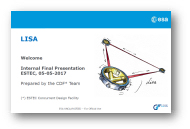ESA Science & Technology - Publications Archive
Publication archive
Publication archive
 |
The internal Phase 0 study of the Laser interferometer Space Antenna (LISA) mission has been performed at ESA's Concurrent Design Facility (CDF) and ran from 8 March to 5 May 2017. An internal final presentation has been prepared by the CDF Team, summarizing the outcome of the Phase 0 study. This presentation can be downloaded as a PDF (28 MB) by clicking the image to the right, or the 'link to publication' link below.
Contents of the presentation:
| p.1 | Introduction | p.195 | TT&C |
| p.6 | CDF Study objectives | p.207 | Data handling |
| p.10 | Science objectives | p.220 | Power |
| p.49 | Systems | p.238 | Mechanisms |
| p.78 | Payload | p.255 | Configuration |
| p.104 | Mission analysis | p.259 | Structures |
| p.124 | Ground segment and operations | p.270 | Thermal control |
| p.135 | DFACS - AOCS | p.282 | Risk |
| p.156 | Chemical propulsion | p.306 | Programmatics / AIV |
| p.172 | Electric propulsion | p.325 | Conclusions |
This report, the so-called Yellow Book, contains the results of ESA's assessment study (Phase 0/A) of the candidate L-class Cosmic Vision mission LISA.
This technical review report for the LISA candidate mission presents the outcome of an ESA internal review of this L-class candidate mission in the Cosmic Vision 2015-2025 plan. The review was concluded at the end of the mission assessment phase and carried out in frame of the down-selection for L-class missions to proceed to the definition phase. The review focused on the technical and programmatic elements of the mission.
The primary goal of the Laser Interferometer Space Antenna (LISA) mission is to detect and observe gravitational waves from massive black holes and galactic binaries in the frequency range 10-4 to 10-1 Hz. This low-frequency range is inaccessible to groundbased interferometers because of the unshieldable background of local gravitational noise, and because ground-based interferometers are limited in length to a few kilometres.
